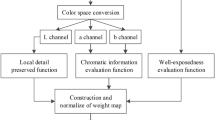Abstract
Multi-exposure fusion is the common approach to generate high dynamic range (HDR) images that combines multi-exposure images captured for the same scene, but the traditional multi-exposure fusion algorithms lose details in the brightest and darkest regions of the scene. Therefore, many detail enhancement-based exposure fusion algorithms have been proposed to extract these details. However, these algorithms have low efficiency because of the complexity of detail enhancement mechanism, and most of them excessively enhance all the pixels besides of the necessary brightest and darkest pixels. We propose a local detail enhancement mechanism to enhance only the details of brightest and darkest regions by using fast local Laplacian filtering (FLLF). A large number of experiments show that the proposed algorithm has much more high efficiency than the current detail enhancement-based exposure fusion algorithms, and the brightest and darkest details in the high dynamic range scene are preserved well.







Similar content being viewed by others
References
Aubry, M., Paris, S., Hasinoff, S.W., Kautz, J., Durand, F.: Fast local Laplacian filters: theory and applications. ACM Trans. Graph. 33(5), 1–14 (2014)
Durand, F., Dorsey, J.: Fast bilateral filtering for the display of high-dynamic-range images. ACM Trans. Graph. 21(3), 257–266 (2002)
Farbman, Z., Fattal, R., Lischinski, D.: Edge-preservingdecompositions for multi-scale tone and detail manipulation. ACM Trans. Graph. 27(3), 67-1-67–10 (2008)
Fei, K., Li, Z., Wen, C., Chen, W.: Edge-preserving smoothing pyramid based multi-scale exposure fusion. J. Vis. Commun. Image Represent. 53, 235–244 (2018)
Fei, K., Zhe, W., Chen, W., Wu, X., Li, Z.: Intelligent detail enhancement for exposure fusion. IEEE Trans. Multimed. 20(1), 484–495 (2018)
Jianbing, S., Ying, Z., Shuicheng, Y.: Exposure fusion using boosting laplacian pyramid. IEEE Trans. Cybern. 44(9), 1579–1590 (2014)
Jianbing, S., Ying, Z., Ying, H.: Detail-preserving exposure fusion using subband architecture. Vis. Comput. 28(5), 463–473 (2012)
Jianrui, C., Shuhang, G., Lei, Z.: Learning a deep single image contrast enhancer from multi-exposure images. IEEE Trans. Image Process. 27(4), 2049–2062 (2018)
Kaiming, H., Jian, S., Xiaoou, T.: Guided image filtering. IEEE Trans. Pattern Anal. Mach. Intell. 35(6), 1397–1409 (2013)
Karr, B.A., Debattista, K., Chalmers, A.G.: Optical effects on HDR calibration via a multiple exposure noise-based workflow. Vis. Comput. 17, 1–16 (2020)
Kede, M., Kai, Z., Zhou, W.: Perceptual quality assessment for multi-exposure image fusion. IEEE Trans. Image Process. 24(11), 3345–3356 (2015)
Li, H., Ma, K., Yong, H., Zhang, L.: Fast multi-scale structural patch decomposition for multi-exposure image fusion. IEEE Trans. Image Process. 29, 5805–5816 (2020)
Li, Z., Wei, Z., Wen, C., Zheng, J.: Detail-enhanced multi-scale exposure fusion. IEEE Trans. Image Process. 26(3), 1243–1252 (2017)
Ma, K., Li, H., Yong, H., Wang, Z., Meng, D., Zhang, L.: Robust multi-exposure image fusion: a structural patch decomposition approach. IEEE Trans. Image Process. 26(5), 2519–2532 (2017)
Mansour, N., Maryam, K., S.M., Reza, S., Nader, K.: Fast exposure fusion using exposedness function. In: IEEE International Conference on Image Processing (ICIP), pp. 2234–2238 (2017)
Mertens, T., Kautz, J., Reeth, F.V.: Exposure fusion: a simple and practical alternative to high dynamic range photography. Comput. Graph. Forum 28(1), 161–171 (2009)
Mingli, S., Dacheng, T., Chun, C., Jiajun, B., Jiebo, L., Chengqi, Z.: Probabilistic exposure fusion. IEEE Trans. Image Process. 21(1), 341–357 (2012)
Paris, S., Hasinoff, S.W., Kautz, J.: Local Laplacian filters: edge-aware image processing with a Laplacian pyramid. In: International Conference on Computer Graphics and Interactive Techniques, pp. 1–12 (2011)
Prabhakar, K.R., Srikar, V.S., Babu, R.V.: Deepfuse: a deep unsupervised approach for exposure fusion with extreme exposure image pairs. In: IEEE International Conference on Computer Vision (2017)
Raman, S., Chaudhuri, S.: Bilateral filter based compositing for variable exposure photography. In: Proceedings of Eurographics Short Papers (2009)
Rui, S., Irene, C., Jianbo, S., Anup, B.: Generalized random walks for fusion of multi-exposure images. IEEE Trans. Image Process. 20(12), 3634–3646 (2011)
Shiguang, L., Yu, Z.: Detail-preserving underexposed image enhancement via optimal weighted multi-exposure fusion. IEEE Trans. Consum. Electron. 65(3), 303–311 (2019)
Shutao, L., Xudong, K., Jianwen, H.: Image fusion with guided filtering. IEEE Trans. Image Process. 22(7), 2864–2875 (2013)
Wei, Z., Cham, W.K.: Gradient-directed composition of multi-exposure images. In: IEEE Conference on Computer Vision and Pattern Recognition, pp. 530–536 (2010)
Zhengguo, L., Jinghong, Z., Susanto, R.: Detail-enhanced exposure fusion. IEEE Trans. Image Process. 21(11), 4672–4676 (2012)
Acknowledgements
This work is supported by the General Program of Natural Science Foundation of the Jiangsu Higher Education Institutions of China (No. 19KJB520007), the Project of High-level Talents Research Foundation of Jinling Institute of Technology (No. jit-b-201802), the Science and Education Integration Project of Jinling Institute of Technology (No. 2020KJRH28) and the Shandong Provincial Natural Science Foundation (No. ZR2019PF023).
Funding
This study was funded by the Project of High-level Talents Research Foundation of Jinling Institute of Technology (No. jit-b-201802), the General Program of Natural Science Foundation of the Jiangsu Higher Education Institutions of China (No. 19KJB520007).
Author information
Authors and Affiliations
Corresponding author
Ethics declarations
Conflict of interest
The authors declare that they have no conflict of interest.
Additional information
Publisher's Note
Springer Nature remains neutral with regard to jurisdictional claims in published maps and institutional affiliations.
Supplementary Information
Below is the link to the electronic supplementary material.
Rights and permissions
About this article
Cite this article
Wang, C., He, C. & Xu, M. Fast exposure fusion of detail enhancement for brightest and darkest regions. Vis Comput 37, 1233–1243 (2021). https://doi.org/10.1007/s00371-021-02079-5
Accepted:
Published:
Issue Date:
DOI: https://doi.org/10.1007/s00371-021-02079-5




